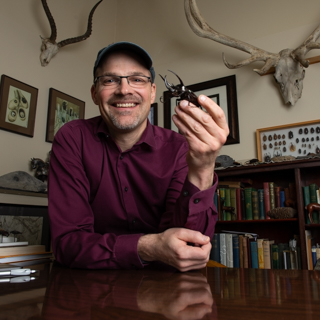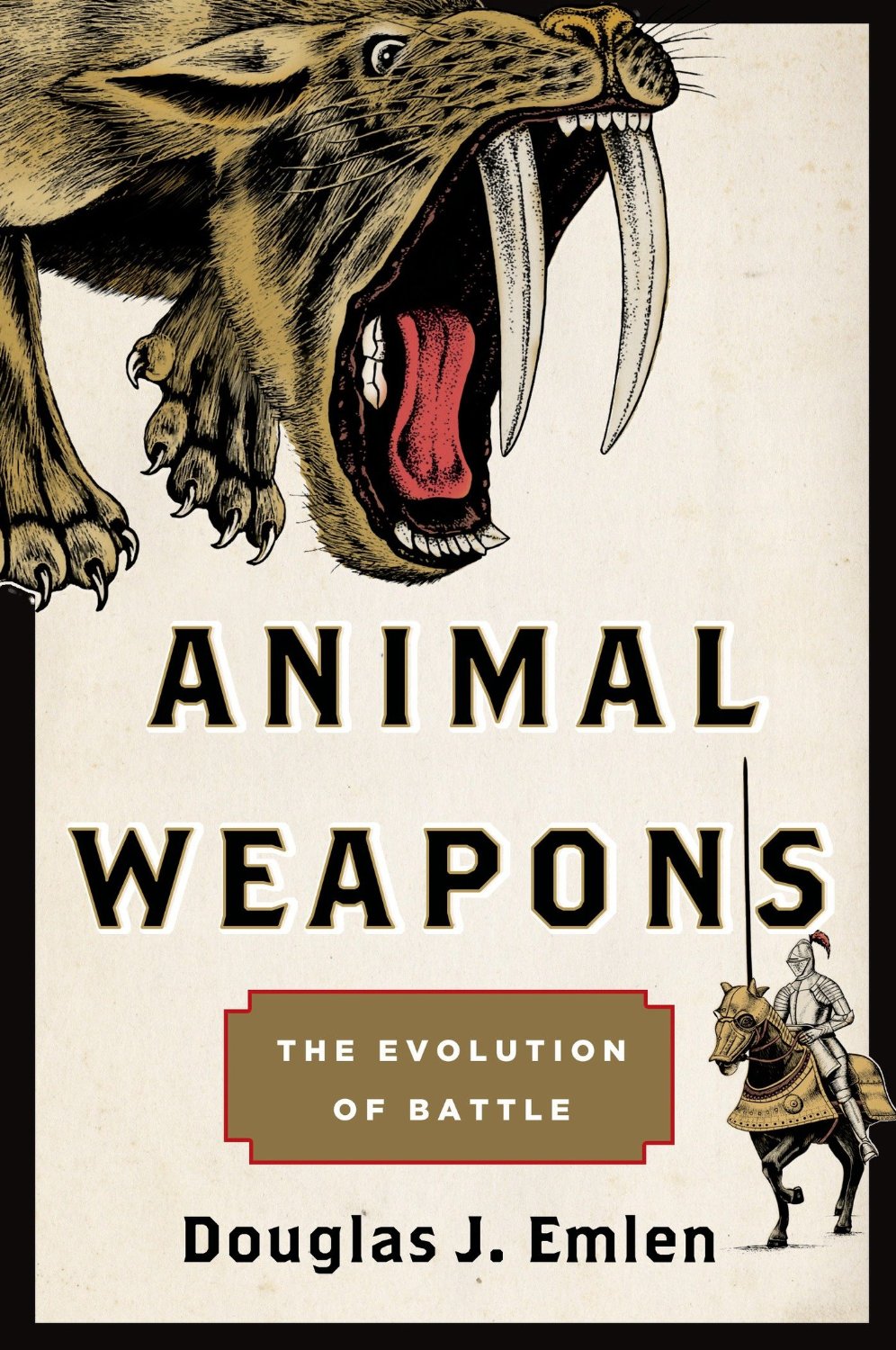Media
Radio Interviews & Podcasts

”Science Friday” with Ira Flatow:
(Public Radio, November 14, 2014)
Horns, Claws, and Teeth: The Animal Weapons Arms Race
Animals have developed horns, claws, and teeth to defend themselves, but what is the advantage of a bulky crab claw that weighs half as much as the entire animal, or 14-foot-wide antlers on the extinct Irish Elk that stood seven feet tall? Doug Emlen, a biologist and author of Animal Weapons, describes the evolutionary arms race that pushes these animal weapons to the extreme.
”On Point” with Jane Clayson:
(NPR, November 7, 2014)
Animal Weaponry, Through the Ages
Animals have natural weaponry: antlers, tusks, teeth and beyond. How does a crab end up with a crushing claw equal to the size of the rest of its body? What is about a tiny piranha teeth that lets it take down much bigger prey? From the giant mandibles and horns of dung beetles to the outsize antlers of the Irish Elk, our guest today evolutionary biologist Douglas Emlen, says animals are sucked into their own biological arms races —just like us humans.
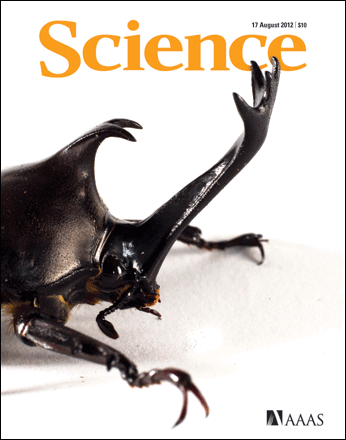
Science Signaling Podcast with Annalisa VanHook
(August 14, 2012)
Signaling pathway regulates growth
Male rhinoceros beetles use their horns to fight one another for access to mates, much like male deer and elk use their antlers to fight for dominance over a group of females. Males with the largest horns generally win more fights, and so they go on to produce more offspring.
Doug Emlen’s group has just completed a story in which they found that the insulin signaling pathway is important for determining the size of the rhinoceros beetle’s horn, and they hypothesize that this same pathway might also be important for regulating the growth of sexually selected male ornaments and weapons in other species (1). Emlen spoke to me by telephone from the University of Montana.
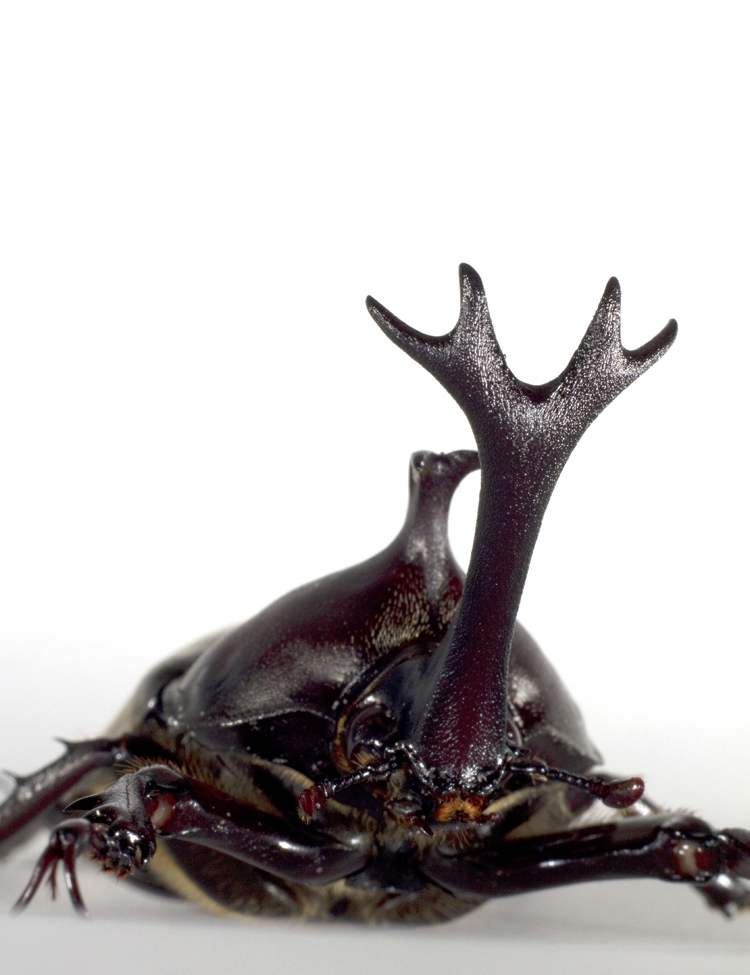
Science VideoLab
(August 2012)
The Healthiest Beetles Grow the Biggest Horns
Exaggerated features such as beetle horns, deer antlers, and long tails in birds are all indications of a male’s breeding status within his society—but until recently, how these sexually selected traits have evolved has remained a mystery.
William Freihofer a graduate student in Journalism at the University of Montana speaks with Douglas Emlen on his research. The Emlen lab has been investigating the evolutionary processes at work in the amply-horned Japanese rhinoceros beetle—and reports that the difference between a big horn and a small horn may come down to nutrition and fitness.

BBC World Service Radio with Beth McCloud
(July 26, 2012)
Growing Long Horns: Why some males are more successful than others
In the animal world it is well established that females favor males with the biggest horns or antlers but nobody has understood how some males are able to grow them more successfully than others. Now new research in the journal of science could shed some light on this question.
Laura Lavine, an associate professor at Washington State University, reveals how a team of researchers have uncovered some new findings. The horns are very responsive to Insulin, which is present at higher levels in animals that eat more or are in better condition. As a result, large horns signal that the male is a good mate.
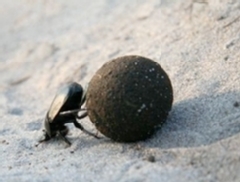
"The WildLife" on WOMM-LP with Laurel Neme
(June 13, 2011)
Dung Beetles: A sewage SWAT team
Dung beetles live all over the world (except in Antarctica) and thrive in virtually every type of habitat, from deserts to rainforests. Their main food source is dung, which provides nutrients and water for both the adults and young.
Doug Emlen, a University of Montana biology professor, reveals the strange and endearing characteristics of dung beetles. He tells “The WildLife” host Laurel Neme about their unique biology and diversity and how the varied shapes of their horns affect their lifestyle.
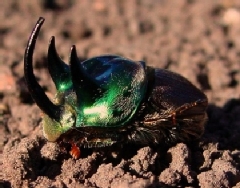
"Fresh Air" with Terry Gross:
(NPR, May 4, 2009)
The Fascinating World Of The Dung Beetle
Underneath the cow patties in the pasture — and the monkey dung in the jungle — there is a miniature world of sex and violence.
Here, ornately decorated beetles armed with horns fight for survival and sexual dominance. Douglas Emlen, a professor of biology at the University of Montana, studies them.
Articles About Our Lab's Research
Natural History: ”Extravagant Weaponry” November 2014
New York Times Magazine: ”The Astonishing Weaponry of Dung Beetles” October 31, 2014
Your Wild Life: ”Before They Were Scientists: Doug Emlen” by Lea Shell, October 16 2014
Not Exactly Rocket Science: ”Rhino Beetle Weapons Match Their Fighting Styles” by Ed Yong, September 9 2014
National Geographic: Weird and Wild: ”Why Do Males Have Built-in Weapons?” by James Owen, September 8 2014
Science: "Insulin may guarantee the honesty of beetle's massive horn" by Elizabeth Pennisi, July 26 2012
Science Daily: "Biological Mechanism for Growing Massive Animal Weapons, Ornaments Discovered" July 26 2012
Nature and Planet: "Insulin Controls Growth of Rhino Beetles Horn" Scarlett Snyder July 29 2012
Science 2.0: "The Insulin-Dependent Rules of Beetle Attraction" July 27 2012
Science in Seconds: "Nice Rack" RHeanna Sand, August 31 2012
AAAS: "In Male Rhinoceros Beetle, Horn Size Signals Healthy Mate" Brandon Bryn, July 26 2012
BBC Nature News: "Big horned rhinoceros beeltes are healthiest" Ella Davies, July 26 2012
Discover Magazine: "How the rhino beetle got its horn (and why it cannot lie)" Ed Young, July 26 2012
Discover Magazine(Loom): "Why you can't fake a good horn" Carl Zimmer, July 26 2012
Science Fair: "Antlers make the beetle" Dan Vergao, July 26 2012
Insects/Sex/Evolution: "Evolution 2012 review, special Doug Emlen edition" Tom Houslay, July 2012
Science News: “Insulin may be Big Antler hormone” by Susan Milius, July 13, 2012.
Nature: “Going Digital: Creating electronic textbooks takes ingenuity, teamwork, and multimedia savvy” by Roberta Kwok, May 2012.
BBC Nature: "Nature's Big Picture: Beetle tracking" May 2012
Current Science: “Arms Race” by Kirsten Weir, April 2011.
Africa Geographic: “Mine are bigger than yours” by John Hanks, September 2010.
Science: "A Horn for an Eye" by Harvey, P.H & Godfray, C.J, December 2009
Scarabs: “Facultative male trimorphism” by Barney Streit, August 2009.
Research View: “Heavily horned: Why are beetles the weaponry champs?” by Deborah Richie Oberbillig, July 2009.
Boing Boing: “The wonderful world of the beetle on Fresh Air” posted by Mark Frauenfelder, May 2009.
Akron News Now: “I heart Terry Gross” by Edward Esposito, May 2009.
Bug Girl’s Blog: “Are there roaches in your coffee and chocolate?” May 2009.
Courthouse News Service: “What biology tells us, or perhaps not” by Robert Kahn, May 2009.
Tages-Anzeiger: "Die auffälligsten Waffen töten nicht" von Daniel Bächtold, April 2009.
NPR “Fresh Air” Interview with Terry Gross: “The fascinating world of the dung beetle” (37 minutes, May 4 2009).
The New York Times: “Extravagant results of nature’s arms race” by Nicholas Wade, March 2009.
El Mercurio: “Artilleria natural dissuade a enemigos y atrade a las hembras” March 2009.
Galley Proofs: "More Insect Phenotypic Funkiness" Feb 18 2009
Cool Earth: "Rainforext beeltes more diverse than originally thought" Feb 2009
Science News: "Dung Beetles Reveal Unexpected Three-Fer" Feb 2009
Nature: Research Highlights, “Horny?” Feb. 2009.
Curious Cat: "Darwin's Beetles Still Producing Surprises" Feb 2009
Odyssey, “The clean machines, dung beetles at work” by Mikki Sadil, March 2008.
Science News For Kids: "Little Beetle, Big Horns" by Roberta Kwok, May 2007
SEED Magazine: “On extravagant proportions” by P.Z. Myers, June 2007.
Pour La Science, December 2006
The Telegraph (India), "Horns of a dilemma:", By Monojit DasGupta, December 4, 2006
Newsweek (Poland), November 11, 2006
SciTini, " Big Horns or Large Testes: A Beetle's Dilemma:", By Karen Wiens, November 6, 2006
India News Channel, "Bigger not necessarily the better when it comes to sexual conquests!", October 25, 2006
ScienceNOW: "Horns vs. heredity" October 24, 2006
Science News: "Horns vs. Sperm: Male beetles on tight equipment budget" by Susan Milius, October 21, 2006
ABC News Online, "Horny beetles have tiny testes:" By Judy Skatsoon, October 17, 2006
South Asia News, (October 17, 2006)
New Scientist Online, "Horniest male beetles have the tiniest testicles" by John Pickrell, October 16, 2006
National Geographic Online, "Big Testes or Big Horns? It's One or the Other for Male Beetles:" By John Roach, October 16, 2006
The Why? Files, Science Behind the News, “Bizarre Beetle Battles” by Paroma Basu, October 14, 2005.
The Loom (“An inordinate fondness for beetle horns” by Carl Zimmer, June 2005)
The Princeton Journal of Science and Technology, “Digging for answers” by Wenfei Tong, (May 2004).
The New York Times Science Times (“A lance, a lunch, or a mate: All for the price of a horn” by Donald McNeil Jr., April 27, 2004)
Smithsonian: Close Encounters of the Sneaky Kind, by Richard Conniff, July (2003).
Nature Australia, "Horny Beetles" (Autumn 2002).
Research View, Beetle Battles: The strange world of horned combatants, by Cary Shimek, Spring 2001;
This Week in Science, by Phil Szuromi, 291: 1443 (2001)
Science's Compass Perspectives article: A horn for an eye, by Paul Harvey and Charles Godfray, 291: 1505-1506 (2001)
USAtoday.com: Evolution of Dung beetle's horn explained, by Lisa Onaga, Feb. 23 (2001)
Science: "Costs and the Diversification of Exaggerated Animal Structures" by Douglas Emlen Volume 291 (2001)
ScienceNow: On the horns of a dilemma, by Menno Schilthuizen, Feb. 28 (2001)
Science Magazine Online: Sizing up dung beetle evolution, by Wade Roush, Feb. 28 (2001)
Study Works! Online: You can't have your horns and big eyes too, by Rachel Clark, Mar. 30,(2001)
GeoSkop Magazine, "Auge gegen horn" May, 2001 p. 204.
Nature Reviews Genetics: "Evo-Devo: The evolution of a new discipline" by Ruddlof A. Raff. Volume 1: 74-79 (October 2000).
BBC Wildlife, "Armless Rivalry" (September 2000, p. 35).
Trends in Ecology and Evolution: Using integrative biology to explore constraints on evolution, by Stephen Trumbo. Volume 14: 5-5 (1999).
Discover Magazine, "Prenatal Competition" (September, 1998, p. 18-19).
Earth Magazine, "Limits on Limbs" (August, 1998, p. 11)
The New York Times: "Competition in Growth of Body Parts" (Science Tuesday, May 5, 1998)
Science News: "Butterfly Wings, Beetle Horns Teach Biologists Basic Lesson's in Development's Law" April 1998, p. 231
Science Daily: "Butterfly Wings, Beetle Horns Teach Biologists Basic Lesson In Development's Laws", April 1998
BBC Wildlife: (December 1997, p. 59) http://www.wiedzaizycie.pl/97122200.htm
Science: "Sizing up dung beetle evolution" by Wade Roush. Volume 277:184 (1997)
Nature, “Taking the Beetle by the Horns” photo story, 369: 359. (1994)
